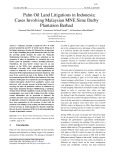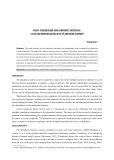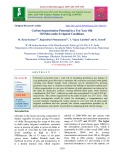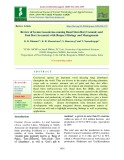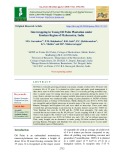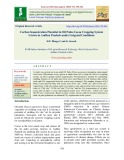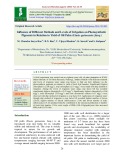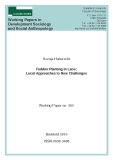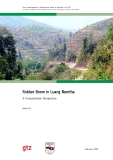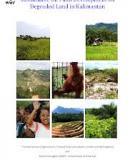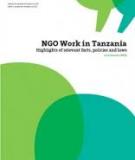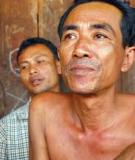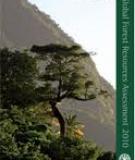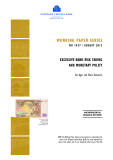
Palm oil plantations
-
This issue if not resolved can lead to the failure of the MNEs’ investment and may affect FDI flows into Indonesia. The main objective of this paper is to examine the case law litigation and related information elicited from qualitative sources and interviews with relevant persons involving land issues in carrying out palm oil plantation ventures in Indonesia by Sime Darby Plantation Berhad (‘SDPB’) (being a subsidiary of Sime Darby Berhad). Qualitative social and legal research methodologies were used in this writing.
 13p
13p  longtimenosee10
longtimenosee10
 26-04-2024
26-04-2024
 1
1
 1
1
 Download
Download
-
This study focuses on the interaction between the stakeholders and companies by analyzing social complexity. The qualitative research approach was employed. Thirty-four various stakeholders were interviewed deeply in unstructured way to collect information.
 9p
9p  vihassoplattner
vihassoplattner
 07-01-2022
07-01-2022
 10
10
 0
0
 Download
Download
-
Terrestrial ecosystems play a vital role in regulating greenhouse gas balance of crop production given the need to minimize the emissions associated with global warming and climate change. Such emissions can be minimized by growing perennial crops such as oil palm to enhance the buildup of terrestrial carbon pool. Carbon sequestration in a ten year old mature oil palm plantation was taken up for the study by destructive analysis.
 5p
5p  nguathienthan8
nguathienthan8
 20-10-2020
20-10-2020
 11
11
 1
1
 Download
Download
-
Ganoderma species are important wood decaying fungi distributed throughout the world. They are diverse in the tropics affecting plantation crops such as coconut, arecanut and oil palm and they also affect ornamental, forest and avenue trees in tropical and temperate areas causing Basal Stem rot/Ganoderma wilt. Basal Stem Rot (BSR), also called Ganoderma wilt in coconut and foot rot in arecanut caused by the different species of Ganoderma is one of the most devastating diseases affecting production and productivity of palms.
 22p
22p  angicungduoc6
angicungduoc6
 22-07-2020
22-07-2020
 10
10
 1
1
 Download
Download
-
Oil Palm is vertically growing perennial crop attains a height of about 20 to 30 meter with economic life of 35 years. It is planted on wider space and under good management it takes three years to utilize entire inter space. Since it is vertically growing perennial crop, there is ample scope for raising intercrops in oil palm plantations during the initial 3-4 years. Hence, attempt was made to suggest suitable intercrops in juvenile oil palm garden.
 10p
10p  nguaconbaynhay6
nguaconbaynhay6
 23-06-2020
23-06-2020
 7
7
 2
2
 Download
Download
-
A study was carried out in an adult Oil Palm (Elaeis guineensis) plantation intercropped with cocoa (Theobroma cocoa) grown in sandy loam soil to study the effect of cropping system on above ground carbon sequestration. Non-destructive method for calculating standing biomass of oil palm and cocoa were used. Based on this biomass data carbon stock and CO2 sequestered from the system were estimated.
 5p
5p  angicungduoc4
angicungduoc4
 26-04-2020
26-04-2020
 11
11
 0
0
 Download
Download
-
Soil carbon dynamics in oil palm - Cocoa cropping system in comparison to that of oil palm sole crop
An investigation was conducted in oil palm sole crop and oil palm + cocoa cropping systems to study microbial diversity along with enzyme activities and understand soil carbon dynamics in oil palm based cropping system. Ten mature oil palm plantations (five each in oil palm sole crop and oil palm + cocoa) planted with Tenera hybrids with a spacing of 9 X 9 X 9 m in a triangular system were selected for the study. Cocoa var. Forastero is cultivated as an intercrop in oil palm plantations at 4.5 X 4.5 m spacing.
 12p
12p  trinhthamhodang1212
trinhthamhodang1212
 06-04-2020
06-04-2020
 8
8
 1
1
 Download
Download
-
A field experiment was carried out on eighteen years old oil palm plantation at ICARIndian Institute of Oil Palm Research, Pedavegi, Andhra Pradesh with different methods and levels of irrigation water using crop factors to find out their influence on the photosynthetic pigments in relation to yield of fresh fruit bunches. Significantly highest chlorophyll-a (2.38 mgg-1 ), total chlorophyll (2.73 mgg-1 ) were found with drip method of irrigation.
 10p
10p  cothumenhmong4
cothumenhmong4
 25-03-2020
25-03-2020
 10
10
 1
1
 Download
Download
-
Vesicular arbuscular mycorrhizae (VAM) are obligate mutualistic symbionts in plant roots cortex and help the absorption of nutrients needed for plants to growth. The research was aimed calculate the spores of VAM and identification to the genus of level. This research has been carried out laboratory analysis in February 2015 to June 2015. The research was conducted by field survey. The purposive sampling area was an oil palm plantation field difference in plant ages.
 8p
8p  caygaocaolon2
caygaocaolon2
 14-03-2020
14-03-2020
 14
14
 0
0
 Download
Download
-
Maize has been cultivated in Ghana for several hundred years. After being introduced in the late 16th century, it soon established itself as an important food crop in the southern part of the country. Very early on, maize also attracted the attention of commercial farmers, although it never achieved the economic importance of traditional plantation crops, such as oil palm and cocoa.
 65p
65p  loixinloi
loixinloi
 08-05-2013
08-05-2013
 60
60
 7
7
 Download
Download
-
A well-known and important exception to the superior performance of owner-operated units of production over those relying on wage labor is in plantation crops, where economies of scale in processing and the need for close coordination of production and processing can make plantations more efficient. The need for quick processing of some harvest products to avoid deterioration, often within 24-48 hours, requires tight adherence to delivery and harvesting schedules and transmits economies of scale in processing to the production stage (Binswanger and Rosenzweig 1986).
 30p
30p  thieubaotrang
thieubaotrang
 23-04-2013
23-04-2013
 51
51
 3
3
 Download
Download
-
The perennial crop sector in Southeast Asia illustrates the plantation model of large-scale farming. Malaysia and Indonesia produce nearly 90 percent of the world’s palm oil, production of which has expanded rapidly in response to growing global demand for edible oils and strong government support. In Indonesia, planted area more than doubled from about 2.9 million ha in 1997 to 6.3 million ha in 2007. In contrast to annual crops, oil palm is highly labor intensive and the industry is estimated to have created an estimated 1.7 to 3 million jobs.
 179p
179p  thieubaotrang
thieubaotrang
 23-04-2013
23-04-2013
 50
50
 5
5
 Download
Download
-
While the rubber trees are immature, selected legume cover crops such as Pueraria phoseoloides, Culopogonium mucunoides and Centrosemu pubescens may be grown on rubber plantations. Intercropping can be carried out with coconut trees and banana plants within the rubber plantation. Sometimes banana alone is used as an intercrop. Intercropping can also be carried out with rice, longgong, mangosteen, satow, bamboo, jampada, riang, durian, pineapple, coffee trees, neem and hot pepper (ITTO, 2000).
 0p
0p  thieubaotrang
thieubaotrang
 23-04-2013
23-04-2013
 57
57
 3
3
 Download
Download
-
The current production of rubber is 2.87 million tonnes per year and export is 2.57 million tonnes per year. The remnants are domestically used. The important trading partners of Thailand are China, Japan, Malaysia and USA. The rubber price during 1999-2003 gradually decreased from 1998 until 2000. The government had to interfere in the mid-2000. However, the rubber price has been increasing since the end of 2000 due to the world demand and expansion of world economy. The rubber plantation industry is dominated by the small holding sector accounting for 95% in terms of area.
 108p
108p  thieubaotrang
thieubaotrang
 23-04-2013
23-04-2013
 58
58
 6
6
 Download
Download
-
The Land Resources Development Centre, one of the scientific units of the Overseas Development Administration, assists developing countries in mapping, investigating and assessing land resources, and makes recommendations on the use of these resources for the development of agriculture, livestock husbandry and forestry; it also gives advice on related subjects to overseas governments and organisations, makes scientific personnel available for appointment abroad and provides lectures and training courses in the basic techniques of resource appraisal and development.
 123p
123p  thieubaotrang
thieubaotrang
 23-04-2013
23-04-2013
 46
46
 5
5
 Download
Download
-
The Pest Risk Analysis on South American Leaf Blight, The Contingency Plan for South American Leaf Blight of Rubber and the Model Work Plan for the Importation of Budded Stumps or Budwood of Hevea are supporting documents for the implementation of the Regional Standards for Phytosanitary Measures No. 7 – Guidelines for Protection against South American Leaf Blight of Rubber. These documents reflect the most up-to-date progress of APPPC in terms of management of SALB and are essential references for protection against SALB in Asia and Pacific region.
 0p
0p  thieubaotrang
thieubaotrang
 23-04-2013
23-04-2013
 74
74
 3
3
 Download
Download
-
Palm oil production in Cameroon is expected to rise by about 6% per annum from 1980 to 1985 to 138 000 t and consumption by 4.5% per annum over the same period to 106 000 t , leaving 32 000 t available for export. By 1985 CAMDEV should be producing about 26 000 t. Future consumption in Cameroon is expected to grow at about 4.5% per annum and given the present per caput consumption of about 10 kg per annum, this growth must continue well into the future before the saturation level of about 30 kg...
 31p
31p  thieubaotrang
thieubaotrang
 23-04-2013
23-04-2013
 44
44
 2
2
 Download
Download
-
Subsistence agriculture to produce cassava, plantains, cocoyams, yams, maize, ground- nuts, etc, mainly for home consumption, is the main activity on the plain. Small quantities of cocoa (for sale) and coffee (mainly for home consumption) are produced. There are smallholder cooperative associations at lloani and Mbongo villages which pro- duce palm oil , from two small Stork mills of 5t FFB per day capacity. The oi l is sold on the local market through the Catholic Mission at Mbonge. Members earn about 110 000 CFAF a year from palm oil .
 0p
0p  thieubaotrang
thieubaotrang
 23-04-2013
23-04-2013
 50
50
 3
3
 Download
Download
-
This has given rise to concerns about oil palm expansion contributing to the loss of biodiversity, greenhouse gas emissions, and social conflict due to a fail- ure to recognize local land rights.With expected further increases in palm oil demand, directing plantation expansion away from standing forest toward degraded grassland areas will be important. Estimates suggest that the area available under these degraded areas is at least double what is needed to satisfy increased demand over the next decade.
 34p
34p  enterroi
enterroi
 02-02-2013
02-02-2013
 34
34
 3
3
 Download
Download
CHỦ ĐỀ BẠN MUỐN TÌM








